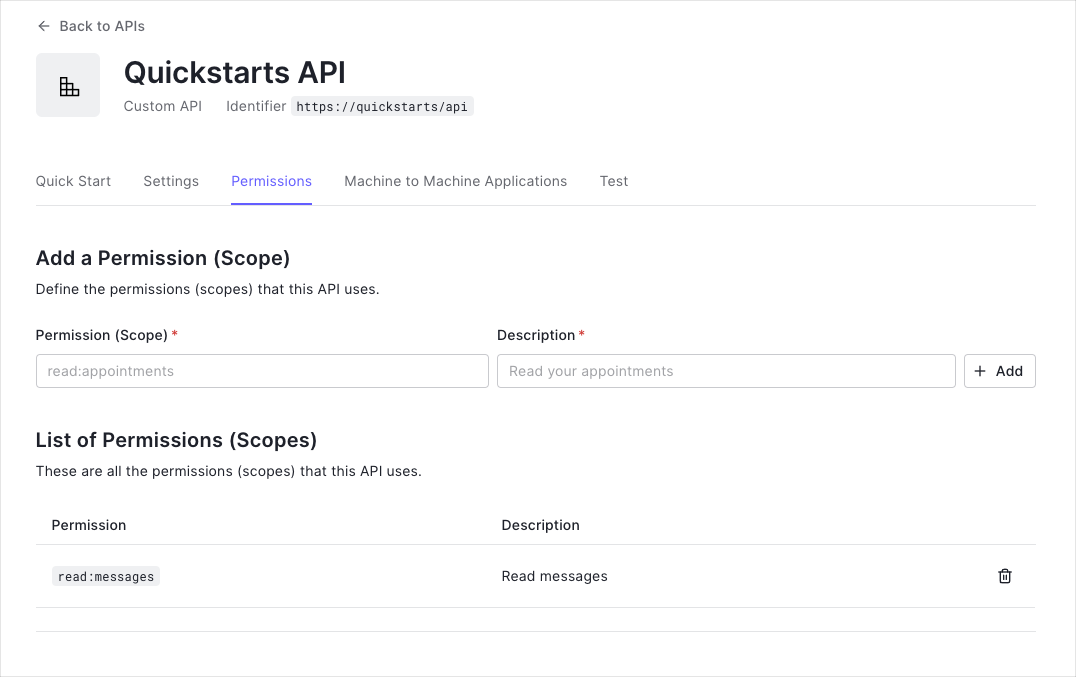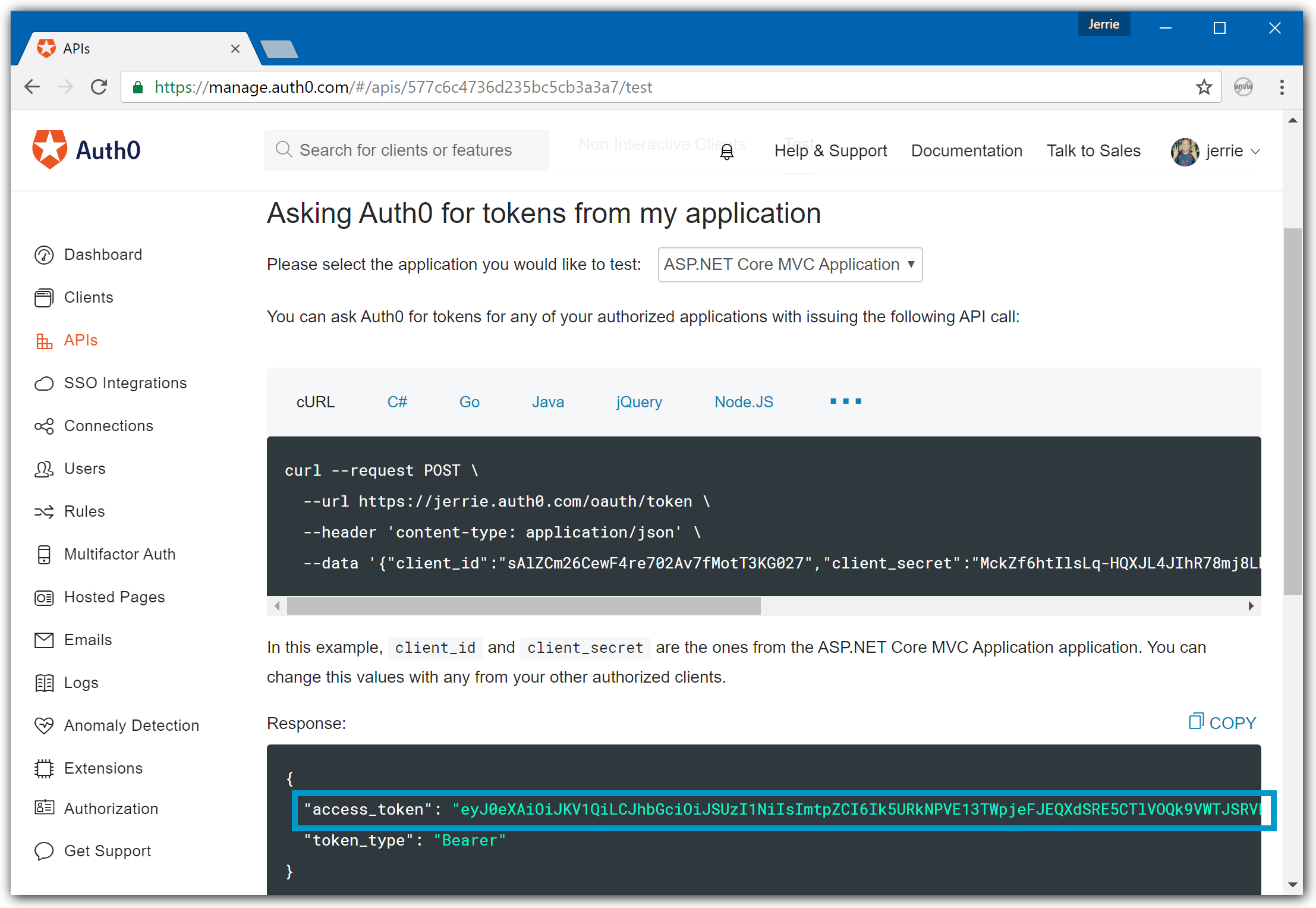Add Authorization to a Flask API application
This guide demonstrates how to integrate Auth0 with any new or existing Python API built with Flask.
If you haven't created an API in your Auth0 dashboard yet, you can use the interactive selector to create a new Auth0 API or select an existing API that represents the project you want to integrate with.
Alternatively, you can read our getting started guide that helps you set up your first API through the Auth0 dashboard.
Every API in Auth0 is configured using an API Identifier that your application code will use as the Audience to validate the Access Token.
Permissions let you define how resources can be accessed on behalf of the user with a given access token. For example, you might choose to grant read access to the messages resource if users have the manager access level, and a write access to that resource if they have the administrator access level.
You can define allowed permissions in the Permissions view of the Auth0 Dashboard's APIs section.

Configure Flask to Use Auth0
Add the following dependencies to your requirements.txt:
# /requirements.txt
flask
AuthlibWas this helpful?
We're going to use a library called Authlib to create a ResourceProtector, which is a type of Flask decorator that protects our resources (API routes) with a given validator.
The validator will validate the Access Token that we pass to the resource by checking that it has a valid signature and claims.
We can use AuthLib's JWTBearerTokenValidator validator with a few tweaks to make sure it conforms to our requirements on validating Access Tokens.
To create our Auth0JWTBearerTokenValidator we need to pass it our domain and audience (API Identifier). It will then get the public key required to verify the token's signature and pass it to the JWTBearerTokenValidator class.
We'll then override the class's claims_options to make sure the token's expiry, audience and issue claims are validated according to our requirements.
Next we'll create a Flask application with 3 API routes:
/api/publicA public endpoint that requires no authentication./api/privateA private endpoint that requires a valid Access Token JWT./api/private-scopedA private endpoint that requires a valid Access Token JWT that contains the givenscope.
The protected routes will have a require_auth decorator which is a ResourceProtector that uses the Auth0JWTBearerTokenValidator we created earlier.
To create the Auth0JWTBearerTokenValidator we'll pass it our tenant's domain and the API Identifier of the API we created earlier.
The require_auth decorator on the private_scoped route accepts an additional argument "read:messages", which checks the Access Token for the Permission (Scope) we created earlier.
Make a Call to Your API
To make calls to your API, you need an Access Token. You can get an Access Token for testing purposes from the Test view in your API settings.

Provide the Access Token as an Authorization header in your requests.
curl --request GET \
--url http://your-domain.com/api_path \
--header 'authorization: Bearer YOUR_ACCESS_TOKEN_HERE'Was this helpful?
var client = new RestClient("http://your-domain.com/api_path");
var request = new RestRequest(Method.GET);
request.AddHeader("authorization", "Bearer YOUR_ACCESS_TOKEN_HERE");
IRestResponse response = client.Execute(request);Was this helpful?
package main
import (
"fmt"
"net/http"
"io/ioutil"
)
func main() {
url := "http://your-domain.com/api_path"
req, _ := http.NewRequest("GET", url, nil)
req.Header.Add("authorization", "Bearer YOUR_ACCESS_TOKEN_HERE")
res, _ := http.DefaultClient.Do(req)
defer res.Body.Close()
body, _ := ioutil.ReadAll(res.Body)
fmt.Println(res)
fmt.Println(string(body))
}Was this helpful?
HttpResponse<String> response = Unirest.get("http://your-domain.com/api_path")
.header("authorization", "Bearer YOUR_ACCESS_TOKEN_HERE")
.asString();Was this helpful?
var axios = require("axios").default;
var options = {
method: 'GET',
url: 'http://your-domain.com/api_path',
headers: {authorization: 'Bearer YOUR_ACCESS_TOKEN_HERE'}
};
axios.request(options).then(function (response) {
console.log(response.data);
}).catch(function (error) {
console.error(error);
});Was this helpful?
#import <Foundation/Foundation.h>
NSDictionary *headers = @{ @"authorization": @"Bearer YOUR_ACCESS_TOKEN_HERE" };
NSMutableURLRequest *request = [NSMutableURLRequest requestWithURL:[NSURL URLWithString:@"http://your-domain.com/api_path"]
cachePolicy:NSURLRequestUseProtocolCachePolicy
timeoutInterval:10.0];
[request setHTTPMethod:@"GET"];
[request setAllHTTPHeaderFields:headers];
NSURLSession *session = [NSURLSession sharedSession];
NSURLSessionDataTask *dataTask = [session dataTaskWithRequest:request
completionHandler:^(NSData *data, NSURLResponse *response, NSError *error) {
if (error) {
NSLog(@"%@", error);
} else {
NSHTTPURLResponse *httpResponse = (NSHTTPURLResponse *) response;
NSLog(@"%@", httpResponse);
}
}];
[dataTask resume];Was this helpful?
$curl = curl_init();
curl_setopt_array($curl, [
CURLOPT_URL => "http://your-domain.com/api_path",
CURLOPT_RETURNTRANSFER => true,
CURLOPT_ENCODING => "",
CURLOPT_MAXREDIRS => 10,
CURLOPT_TIMEOUT => 30,
CURLOPT_HTTP_VERSION => CURL_HTTP_VERSION_1_1,
CURLOPT_CUSTOMREQUEST => "GET",
CURLOPT_HTTPHEADER => [
"authorization: Bearer YOUR_ACCESS_TOKEN_HERE"
],
]);
$response = curl_exec($curl);
$err = curl_error($curl);
curl_close($curl);
if ($err) {
echo "cURL Error #:" . $err;
} else {
echo $response;
}Was this helpful?
import http.client
conn = http.client.HTTPConnection("your-domain.com")
headers = { 'authorization': "Bearer YOUR_ACCESS_TOKEN_HERE" }
conn.request("GET", "/api_path", headers=headers)
res = conn.getresponse()
data = res.read()
print(data.decode("utf-8"))Was this helpful?
require 'uri'
require 'net/http'
url = URI("http://your-domain.com/api_path")
http = Net::HTTP.new(url.host, url.port)
request = Net::HTTP::Get.new(url)
request["authorization"] = 'Bearer YOUR_ACCESS_TOKEN_HERE'
response = http.request(request)
puts response.read_bodyWas this helpful?
import Foundation
let headers = ["authorization": "Bearer YOUR_ACCESS_TOKEN_HERE"]
let request = NSMutableURLRequest(url: NSURL(string: "http://your-domain.com/api_path")! as URL,
cachePolicy: .useProtocolCachePolicy,
timeoutInterval: 10.0)
request.httpMethod = "GET"
request.allHTTPHeaderFields = headers
let session = URLSession.shared
let dataTask = session.dataTask(with: request as URLRequest, completionHandler: { (data, response, error) -> Void in
if (error != nil) {
print(error)
} else {
let httpResponse = response as? HTTPURLResponse
print(httpResponse)
}
})
dataTask.resume()Was this helpful?
Next Steps
Excellent work! If you made it this far, you should now have login, logout, and user profile information running in your application.
This concludes our quickstart tutorial, but there is so much more to explore. To learn more about what you can do with Auth0, check out:
- Auth0 Dashboard - Learn how to configure and manage your Auth0 tenant and applications
- auth0-python SDK - Explore the SDK used in this tutorial more fully
- Auth0 Marketplace - Discover integrations you can enable to extend Auth0’s functionality

Sign up for an or to your existing account to integrate directly with your own tenant.